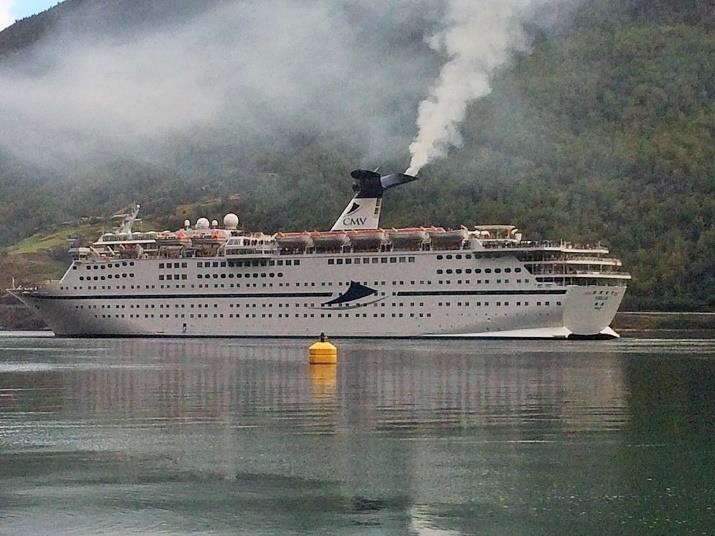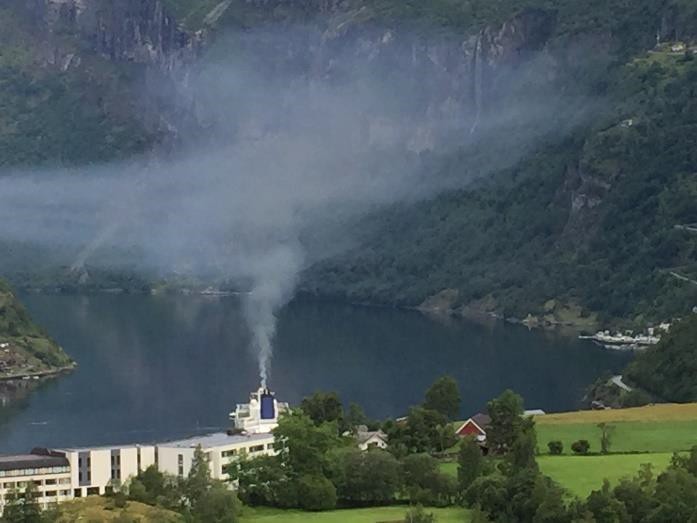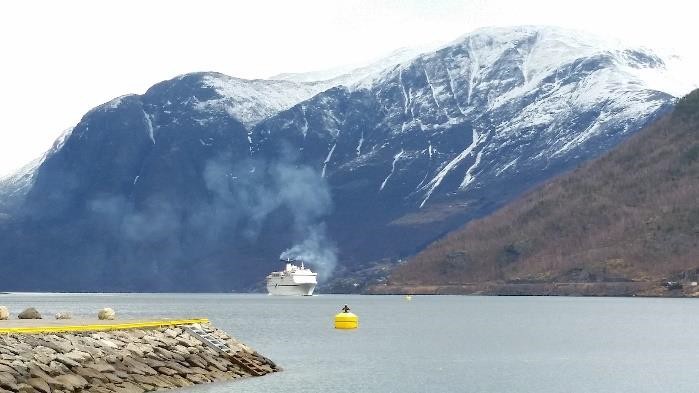DNV GL has on behalf of the NMA quantified the effects of reducing cruise ship speeds on discharges to air and sea.
EXCERPTS FROM THE REPORT
on mapping of discharges and emissions in fjord areas with heavy cruise traffic
Summary
On assignment from the Ministry of Climate and the Environment (MCE), the Norwegian Maritime Authority (NMA) has coordinated and carried out a survey in order to map discharges and emissions in Norwegian fjords with heavy cruise traffic. The assignment was limited to the three world heritage fjords the Geirangerfjord, the Nærøyfjord and the Aurlandsfjord.
The NMA commissioned Rambøll to carry out a comprehensive survey of discharge to sea and emissions to air from cruise ships, Hurtigruten and local traffic in the three selected fjords. This was important in order to assess the risk of possible impacts on health and harm to the natural environment in these three fjord areas.
The NMA has mapped the applicable rules and regulations, both the regulation and management of the world heritage areas and legislation related to discharge and emissions from ships. As part of the process, there have been several meetings with various interested parties, who have contributed both in discussions and with written suggestions. In addition, the different problems at hand have been discussed with the Norwegian Environment Agency, the Norwegian Coastal Administration and the MCE.
World heritage sites as beacons
World heritage sites shall have a high status in Norway. This is ascertained in Storting White Paper No. 35 (2012-2013), "Future with foothold":
"The Norwegian level of ambition for honouring the commitments laid down in the Convention is high: The preservation of Norwegian world heritage areas shall be beacons for best practice for culture and nature management, cf. Storting White Paper No. 26 (2006–2007), The Government's Environmental Policy and the state of the Environment."
The results from this survey should therefore be seen as a contribution to ensure that the intention of the white paper is achieved. This includes both measures directed at discharge and emissions and measures that could strengthen the management of the world heritage fjords.
NOx periodically above the limit
Based on the scientific assessments and surveys made, it emerges that the level of nitrogen oxides (NOx) in Geiranger and Flåm at times exceed values that could have a negative impact on health. NOx together with soot/smoke particles and water vapour also contribute to the formation of smoke clouds in the fjords. In periods, the combination of older ship machinery, emissions, the number of ships and meteorological conditions leads to high formation of smoke.
The mapping conducted in the project shows that there is little discharge into the fjords from the cruise ships, but Hurtigruten and local ship traffic discharge some sewage and grey water.
Most ships operating in the fjords were built before 2000 and have engines without modern technology for reducing pollution. This leads, among other things, to emissions of particulate matter, sulphur oxides (SOx) and nitrogen oxides (NOx). Nevertheless, the emissions of SOx are not large enough to exceed the air quality criteria. This is due to the fact that the fuel used in the fjords has a low sulphur content or that scrubbers (exhaust gas cleaning systems) are being used.
The ships' operational patterns, such as speed, engine load, coordination of engines and time spent at berth/anchor, also effect the amount of emissions to air.
Proposal for specific measures
Based on the results from the survey, the NMA suggests several measures to reduce discharges and emissions and the negative impact on the environment in the Geirangerfjord, Nærøyfjord and Aurlandsfjord.
- The emission of NOx from ships shall not exceed the values set out in MARPOL Annex VI, regulation 13.4 (Tier II) by 2018 and regulation 13.5 (Tier III) by 2020
- Only allow use of fuel with a low sulphur content, regardless of whether the ship has air pollution control devices (scrubbers) installed
- Visible emissions of smoke from ships shall have a density that reduces transparency by not more than 50% during cold start or 10% when underway
- Reporting requirements for all ships entering world heritage fjords
- Reducing the number of calls at port; total number or per day/week
- Determination of max speed in defined zones in the fjords to keep consumption of fuel and emissions to a minimum
- Prohibition against discharge of scrubber water
- Prohibition against discharge of grey water
- Prohibition against discharge of sewage, untreated and treated
When determining entry into force of regulatory requirements, the industry's possibilities for compliance must be taken into account. The provisions must also open for dispensations.



